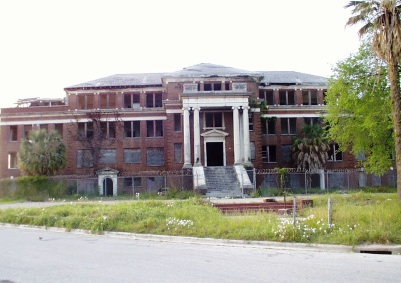Near downtown Houston, there is an enormous graveyard full of slaves, confederate solders, members of secrete societies and even a mass grave containing the jumbled remains of victims from the 1867 yellow fever outbreak. This purportedly haunted grave yard has designated places for “Paupers, Negroes, Families and those that committed suicide or died in a duel.” While the cemetery is large and packed full of human remains, you wouldn’t know 10,000 corpses were under your feet if you took a walk through the cemetery today because the headstones were removed and an insane asylum was built over the graves.

That’s right. You might be thinking of the movie Poltergeist right now and you wouldn’t be far from the truth. In 1986, construction on the Houston Fire Department maintenance building unearthed dozens of unmarked graves. Legend has it that a number of human bones were stolen by locals who came out to gawk at the then exposed graves.
Numerous stories of ghostly doctors, nurses and patients exist and activity is supposedly concentrated on the 3rd floor of the hospital. Some paranormal investigators have photographed what they claim to be ghostly “orbs” floating in front of the hospital. A local paranormal organization called Lone Star Spirits claims that they’ve received first-hand reports from people who claim that ghosts followed people home after visiting the old hospital. To me, stories like this are very reminiscent of the supposed Demon Road haunting and just as credible.
On April 8, 1840, the City of Houston purchased five acres in the First Ward from brothers Henry R. and Samuel L. Allen for $750. This became Houston’s first City-owned cemetery and was the second cemetery built in Houston. The 1840 City ordnance that established the cemetery stated that the cemetery would be segregated into four sections: “1.) A Potters Field for criminals, suicides and the persons killed in duels; 2.) the Negroes Burying Ground; 3.) the Commons for all not otherwise provided for; and, 4.) Family Plots for sale to the highest bidder. Later, a special section of the cemetery was set aside for members of the Independent Order of Odd Fellows and the Masons. The City discontinued use of the cemetery in 1879. Afterwards, the only new burials that took place occurred in family plots – the last of which took place in 1904.

The Jefferson Davis hospital was named after the President of the Confederacy and is built on the graves of slaves and confederate solders alike. It’s estimated that as many as 3,000 graves lie under the hospital. The hospital was built in 1924 and features an above-ground basement because the builders didn’t want to disturb the graves.

The only accessible evidence that this location is in fact a cemetery full of human remains is the concrete curbing surrounding the Super family plot which now serves as a flower bed. This evidence remains because during the construction of the hospital, Mr. Super stood vigil over his family plot with a loaded shotgun. It’s reported that Super actually took a few pot-shots at construction workers who got too close to his family’s remains. In 2006 a new marker was placed withing the confines of the Fire Department maintenance facility to remember the confederate solders buried under the parking lot of the Houston Fired Department maintenance building.
The first floor of the old hospital held the pharmacy and the so-called “negro-ward.” The second floor held staff quarters and the men’s ward. The third floor held the women’s ward an asylum complete with padded rooms. The fourth floor held the children’s ward. The hospital closed its doors after only 13 years of service and a new larger hospital was built on Allen Parkway. The old hospital was used for various purposes over the years (including acting a psychiatric hospital, STD clinic and a City storage building) before being completely abandoned in the 1990s.

Today the old Jefferson David Hospital is knowns as the “Elder Street Artist Lofts.” While the hospital was rehabed, its old power station was not is still stands in ruins:



The only other interesting structures are these two abandoned homes that stand empty across the street from the abandoned power house:

Perhaps the most interesting and noteworthy thing about this plot of land is that when the Fire Department expansion uncovered human remains, archaeologists uncovered graves that were much, much older than any that should be in the area. In 1986 Ken Brown, professor of Archeology at the University of Houston led a team of researchers who discovered 40 graves which dated back to the 1600s. Both the burial style and accompanying pottery discovered with the remains are consistent with English practices for the disposal of diseased bodies.
10,000 Forgotten Graves http://t.co/HSMbESAjvG [http://t.co/BTPAAY4u6x]
RT @Houstorian: 10,000 Forgotten Graves // Some date back to the 1600s!
http://t.co/hl9D8JOUEe
RT @Houstorian: 10,000 Forgotten Graves http://t.co/8uNE5IjS6v
“@Houstorian: 10,000 Forgotten Graves http://t.co/TcqrBNBljh” interesting! @EcclesiaHouston